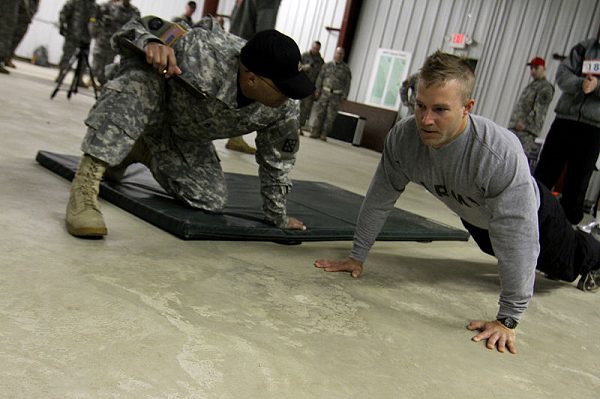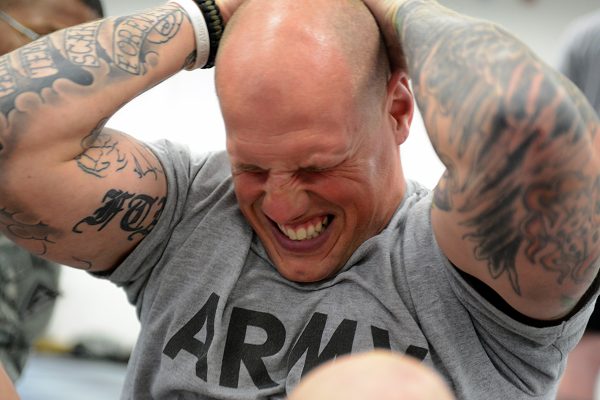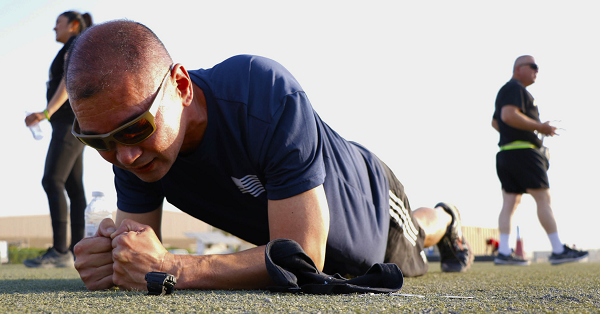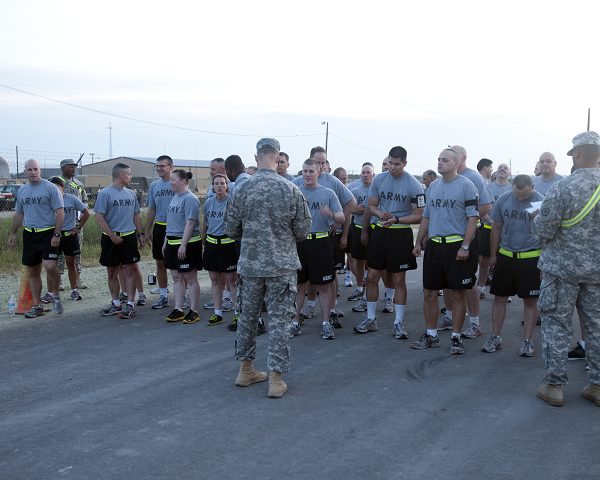If you are considering joining the Army, you might wonder if you are physically ready to perform Army push-ups and sit-ups.
When you enter basic training, you will need to perform with a minimum score on the Basic Training Physical Fitness Test.
As you progress through training and your Army career, you must earn higher scores for physical fitness because you will continue training independently.
At first, your goal is to meet the minimum of a score of 50 in each event.
When you graduate AIT, which is your Advanced Individual Training for your Army job, your minimum goal is 60 each event.
Also, it helps to understand how Army push-ups and sit-ups are supposed to look and how to prepare with your workout before you head off to basic training.
Lastly, the Army is changing how it evaluates the fitness level of soldiers so that you can expect changes coming in October.
Related Article – Army Combat Fitness Test (ACFT) Standards
What are the Army Push up Standards?

The Army push-up standards depend on where you are in your training because you must perform more push-ups as your training continues along.
For example, an 18-year-old male must perform at least 35 push-ups in basic training.
However, if the same person wanted to earn a badge for the physical fitness test, they must perform 64 in two minutes.
Also, total scoring for PT tests includes adding up the scores for multiple events.
Click Here to see tables for the push up standards for males and females ages 18 – 41.
How to Do an Army Push up the ‘Right’ Way
The Army push-up is different than other push-ups.
For an Army push-up, you must take the weight off your hands when at the lower position in between repetitions.
This push-up is sometimes called a T-push-up, but the Army calls it a Hand Release Push-up (HRP).
You will lay prone on the ground with your hands flat.
Your hands will be under your shoulders, with your index finger barely inside the edges of your shoulders.
At this point, your hips and thighs are touching the ground, as is your chest.
However, your head can be upwards.
Keep your feet together with your ankles flexed.
When told to, straighten your arms to push your body upward while maintaining your posture.
Your body must remain in a straight line from head to ankles.
The next move is to lower yourself back down by bending your elbows.
You need your chest, thighs, and hips to touch the ground at the same time.
The final movement in the Army Push-up is to extend your arms to the sides in the shape of a T.
Next, you will return to the position with your hands under your shoulders with your chest, hips, and thighs on the ground.
This video gives you a demonstration of what the Army expects with this movement.
Push-ups are a timed event, so you need to complete as many as you can for two minutes while maintaining good posture.
How to Prep for the Army Push up Test?
To best prepare for success with push-ups, you must add weightlifting into your workout.
To perform a push-up, you need to strengthen your pectoral muscles and triceps.
It would be best if you increased your upper body workout to include exercises that work both the chest and the triceps, as these two muscle groups work together.
Dumbbell and barbell bench presses are ideal.
Also, bench dips and extensions focus on the triceps.
Furthermore, consider adding modified push-ups into your routine until you can remove the modifications and eventually perform standard Army push-ups.
Related Article – Army Basic Training Locations
What are the Army Sit up Standards?

The Army sit-up measures both hip-flexor and abdominal strength.
Scoring for PT tests includes adding up the scores from multiple events for a total score.
The following chart is divided by age groups through 41 so you may see the male/female scores for the number of sit-up repetitions.
| Sit-up Reps | age 17-21 | age 22-26 | age 27-31 | age 32-36 | age 37-41 |
|---|---|---|---|---|---|
| 82 | 100 | ||||
| 81 | 99 | ||||
| 80 | 100 | 98 | |||
| 79 | 99 | 97 | |||
| 78 | 100 | 97 | 96 | ||
| 77 | 98 | 96 | 95 | ||
| 76 | 97 | 95 | 94 | 100 | 100 |
| 75 | 95 | 93 | 92 | 99 | 99 |
| 74 | 94 | 92 | 91 | 98 | 98 |
| 73 | 92 | 91 | 90 | 96 | 97 |
| 72 | 90 | 89 | 89 | 95 | 96 |
| 71 | 89 | 88 | 88 | 94 | 95 |
| 70 | 87 | 87 | 87 | 93 | 94 |
| 69 | 86 | 85 | 86 | 92 | 93 |
| 68 | 84 | 84 | 85 | 91 | 92 |
| 67 | 82 | 83 | 84 | 89 | 91 |
| 66 | 81 | 81 | 83 | 88 | 89 |
| 65 | 79 | 80 | 82 | 87 | 88 |
| 64 | 78 | 79 | 81 | 86 | 87 |
| 63 | 76 | 77 | 79 | 85 | 86 |
| 62 | 74 | 76 | 78 | 84 | 85 |
| 61 | 73 | 75 | 77 | 82 | 84 |
| 60 | 71 | 73 | 76 | 81 | 83 |
| 59 | 70 | 72 | 75 | 80 | 82 |
| 58 | 68 | 71 | 74 | 79 | 81 |
| 57 | 66 | 69 | 73 | 78 | 80 |
| 56 | 65 | 68 | 72 | 76 | 79 |
| 55 | 63 | 67 | 71 | 75 | 78 |
| 54 | 62 | 65 | 70 | 74 | 77 |
| 53 | 60 | 64 | 69 | 73 | 76 |
| 52 | 58 | 63 | 68 | 72 | 75 |
| 51 | 57 | 61 | 66 | 71 | 74 |
| 50 | 55 | 60 | 65 | 69 | 73 |
| 49 | 54 | 59 | 64 | 68 | 72 |
| 48 | 52 | 57 | 63 | 67 | 71 |
| 47 | 50 | 56 | 62 | 66 | 69 |
| 46 | 49 | 55 | 61 | 65 | 68 |
| 45 | 47 | 53 | 60 | 64 | 67 |
| 44 | 46 | 52 | 59 | 62 | 66 |
| 43 | 44 | 50 | 58 | 61 | 65 |
| 42 | 42 | 49 | 57 | 60 | 64 |
| 41 | 41 | 48 | 56 | 59 | 63 |
| 40 | 39 | 47 | 55 | 58 | 62 |
| 39 | 38 | 45 | 54 | 56 | 61 |
| 38 | 36 | 44 | 52 | 55 | 60 |
| 37 | 34 | 43 | 51 | 54 | 59 |
| 36 | 33 | 41 | 50 | 53 | 58 |
| 35 | 31 | 40 | 49 | 52 | 57 |
| 34 | 30 | 39 | 48 | 50 | 56 |
| 33 | 28 | 37 | 47 | 49 | 55 |
| 32 | 26 | 36 | 46 | 48 | 54 |
| 31 | 25 | 35 | 45 | 47 | 53 |
| 30 | 23 | 33 | 44 | 46 | 52 |
| 29 | 22 | 32 | 43 | 45 | 50 |
| 28 | 20 | 31 | 42 | 44 | 49 |
| 27 | 18 | 29 | 41 | 42 | 48 |
| 26 | 17 | 28 | 39 | 41 | 47 |
| 25 | 15 | 27 | 38 | 40 | 46 |
| 24 | 14 | 25 | 37 | 39 | 45 |
| 23 | 12 | 24 | 36 | 38 | 44 |
| 22 | 10 | 23 | 35 | 36 | 43 |
| 21 | 9 | 21 | 34 | 35 | 42 |
How to Do an Army Sit-up the ‘Right’ Way?
To perform an Army sit-up, lie on your back with your legs bent and feet flat on the ground forming a 90-degree angle.
Your heels must stay on the ground, but your toes can come up.
Also, keep your hands locked behind your head with your hands and arms on the ground.
When commanded, you will raise up until your head is in line with the base of your spine.
At this point, you lower your body until your shoulders touch the ground before repeating the movement.
We found you a video that demonstrates this movement.
How to Prep for the Army Sit-up Test?

One way to prepare for Army sit-ups is by practicing each day and setting gradual goals to increase your maximum number of sit-ups.
Also, it is helpful to build up your lower back muscles.
Planks help build not only your back muscles but the rest of your core.
Core strength also includes your abdominal and pelvic muscles, all of which help with your ability to perform a sit-up properly.
Related Article – Marine Initial Strength Test (IST) Standards
Conclusion
The Army takes physical fitness seriously; therefore, it is essential to prepare before you leave for basic training.
The Army has specific expectations for performing both push-ups and sit-ups.
If you do not perform the exercises correctly, the repetition will not count in your total.
Also, you have minimum expectations for these events, and you must reach higher scores as your training progresses.
Lastly, preparing for the Army’s physical fitness test is easy.
All you must do is add in exercises that intentionally target specific muscle groups that will help you during your testing.
References:
- Ikon Pass Military Discount: Learn How To Save Big - January 31, 2025
- RTIC Military Discount: Find Out How To Save Big on Gear - January 30, 2025
- Traeger Military Discount: Learn How To Save Big on Smokers - January 28, 2025


